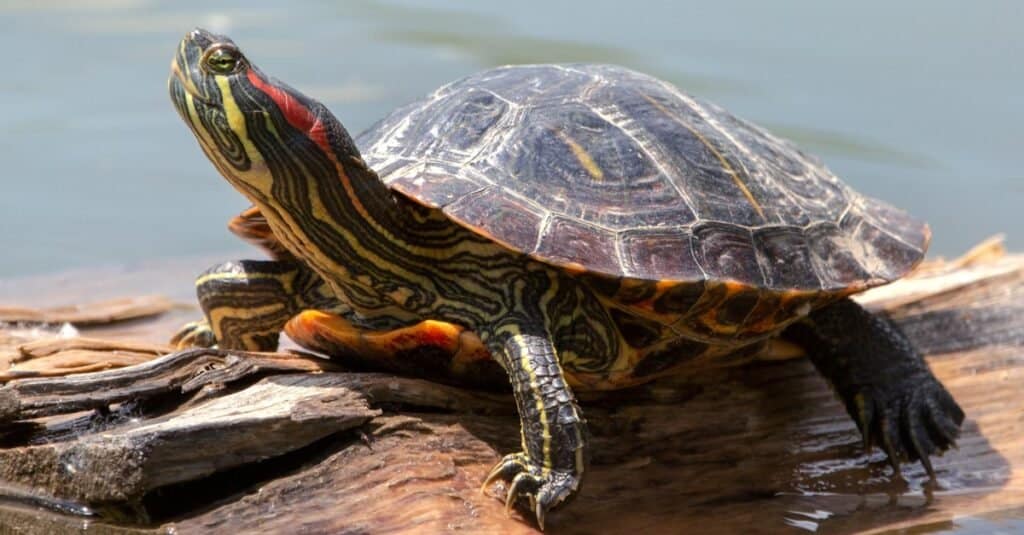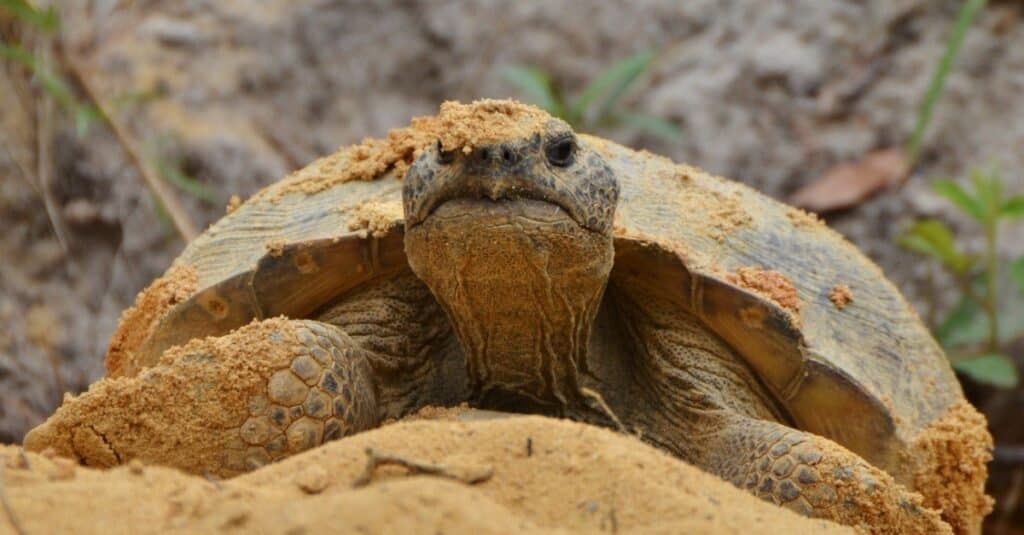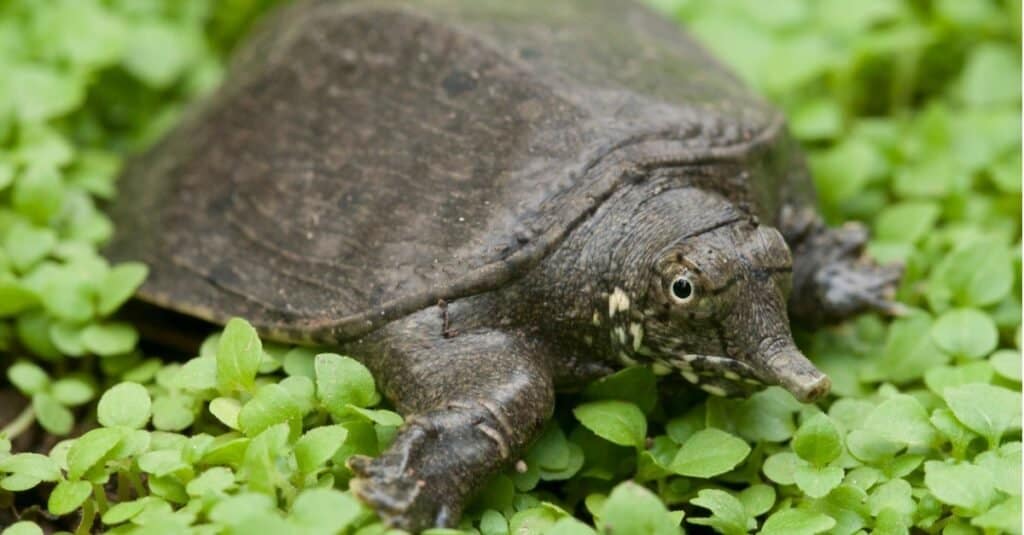Quick Answer
- Reptiles differ from amphibians in that they breathe oxygen through their lungs, and their skin is protected by dry scales to prevent drying out.
- Turtles, including all tortoises and terrapins, are a group of animals with bony shells within the Reptilia class, which makes them reptiles.
If you find turtles as fascinating as we do, you’ve probably spent some time wondering about how we classify these unusual animals–whether the turtle is a reptile or amphibian. Or perhaps something else? Is there any real difference between turtles, tortoises, and terrapins? And what are their shells made of, anyway?
Let’s take a closer look at these truly unique animals and how we group them taxonomically.
What Is a Reptile? What Is an Amphibian?
Before we determine whether or not the turtle is a reptile, it’s important to understand the basic definitions of a reptile vs an amphibian. Both of these animal classifications can be lumped together into a larger group called herpetofauna (herps). Herps are cold-blooded animals who lack an internal thermostat so their body temperature changes with whatever environment they are in.
While both reptiles and amphibians are cold-blooded, as well as semi-aquatic (can live in water or on land), reptiles differ from amphibians in that they breathe oxygen through their lungs, and their skin is protected by dry scales to prevent drying out. Amphibians, on the other hand, absorb oxygen through their moist skin. Animals classified as amphibians include frogs, salamanders, newts, and toads. Some animals we’d classify as reptiles are snakes, lizards, crocodiles, and alligators.
So what would be your guess? Do you think the turtle is a reptile or an amphibian?
Are Turtles Reptiles or Amphibians?

All turtles such as this red-eared pond slider are reptiles.
©Korkin Vadim/Shutterstock.com
Turtles, including all tortoises and terrapins, are a group of animals with bony shells within the Reptilia class, which makes them reptiles! There are currently around 360 total species of turtles in the Tetsudines order, though a handful of them have gone extinct over the years.
All turtles that exist today belong to one of two main groups, or suborders, within the Tetsudines order. These suborders are the side-necked turtles, or Pleurodira, and the hidden-neck turtles, or Cryptodira.
As the common names of these groups suggest, they divide turtles based on how they pull their necks into their shells. All turtles can use their thick, bony shells as a sort of impromptu shelter, pulling their heads and limbs inside them when they are, for example, threatened by a predator or sustaining some kind of damage.
The side-necked turtle is a reptile in the Pleurodira suborder typically having a longer neck than the hidden-neck turtle, and is not able to simply pull its head directly into its shell. Side-necked turtles must bend their necks horizontally and pull their heads in at an angle. Many have long carapaces, or tops of their shells, to help shield their necks and limbs. This group is smaller than Cryptodira and consists solely of freshwater turtles.
Meanwhile, hidden-neck turtles have much shorter necks. This means they can lower their heads slightly and retract their necks and limbs directly into their shells rather than having to fold them at an odd angle. The hidden neck turtle is a reptile that can be freshwater, saltwater, or terrestrial.
While all turtles have eight cervical vertebrae in their necks, the arrangement of these bones is very different depending on whether a turtle is a side-necked or hidden neck variety.
What’s the Difference Between Turtles, Tortoises, and Terrapins?

Tortoises have bodies and shells that are better suited to living terrestrially.
©iStock.com/mjf795
Essentially, all tortoises and terrapins are classified as turtles, but not all turtles are tortoises or terrapins! Typically, tortoises are large-bodied, strictly land-dwelling, and far better suited to burrowing than swimming. Terrapins are a particular variety of small-bodied, freshwater-dwelling turtles.
All tortoises are part of the Testudinidae family. This group includes turtles like the Aldabra giant tortoise and the Russian tortoise. Meanwhile, terrapins don’t have a singular grouping and can be a part of a few different families, most notably Geoemydidae and Emydidae. Terrapins include turtles like red-eared sliders, European pond terrapins, and diamondback terrapins.
One of the biggest differences between tortoises and turtles (and terrapins) is the structure of their feet. Because tortoises are more terrestrial, they have thicker, chunkier feet with ridged scales perfect for digging. Turtles and terrapins are usually at least partially aquatic. Some varieties, like sea turtles, spend most of their lives in water. As a result, they have flatter, more flipper-shaped, or webbed feet to help them swim.
Another quality that makes tortoises distinct from typical turtles is their shell size and shape. Tortoises usually have very large, thick, tank-like, dome-shaped shells to help protect them from predators. Turtles and terrapins generally have flatter, thinner, and more lightweight shells. This makes them better suited to swimming and staying buoyant in water.
Finally, turtles and terrapins are usually omnivorous, while tortoises are almost always strict herbivores. This variance in their diets is mainly due to the differences in their habitats and body plans.
Do All Turtles Have Shells?

All turtles have shells that consist of two main parts: the carapace and the plastron.
©dwi putra stock/Shutterstock.com
One of the main traits that all turtles share, including all tortoises and terrapins, is a shell made of bone and keratin. This is the main unifying trait of all turtles.
All turtle shells consist of two main parts: a carapace and a plastron. The carapace is the larger piece of the shell that covers the top and sides of the turtle’s body. The plastron is the smaller piece of the shell that covers the turtle’s belly.
Both the carapace and plastron are made up of various smaller, interconnected bones that form the entirety of the shell. Most turtles’ carapaces consist of around 50 to 60 individual bones, while plastrons usually only have around ten bones.
The carapace is partially fused to the turtle’s spine and ribs. Additionally, the plastron is fused with the turtle’s ribs and sternum. This means their shells are attached to their bodies and not detachable like those of hermit crabs. As we touched on earlier, land-dwelling tortoises typically have larger, heavier, and more dome-shaped shells. More aquatic turtles and terrapins have flatter, more lightweight shells that won’t weigh them down while swimming.
On the surface of a turtle’s shell are thick, connected scales known as scutes. Like other reptiles’ scales, they are made of keratin.
Even soft-shelled turtles in the Trionychidae family have bony shells! However, the bones are significantly smaller and more simplified than those of most other turtles. This gives them a softer and more flexible structure. They also lack scutes.
The photo featured at the top of this post is © iStock.com/SteveByland
Thank you for reading! Have some feedback for us? Contact the AZ Animals editorial team.






